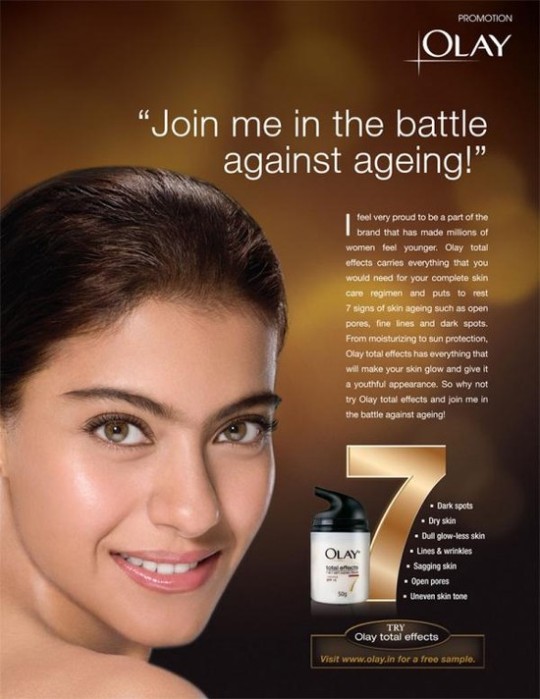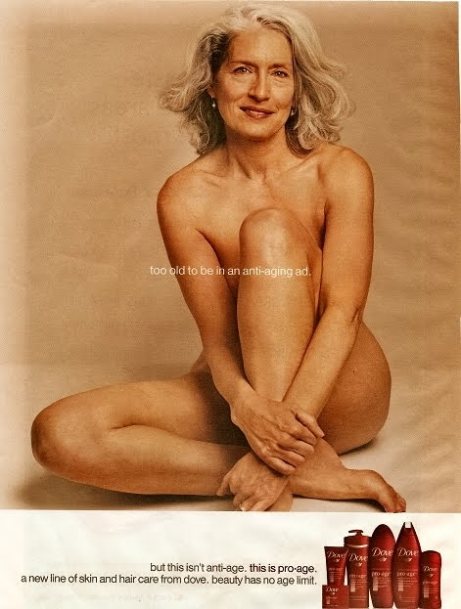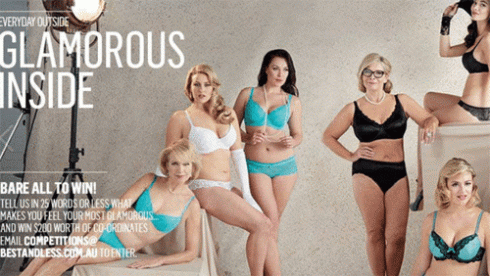“As far as a skin company is concerned: looking young is good old is bad . . . if we do not look young, we are not beautiful. And if we are not beautiful, we are not happy and not confident” (Chen, 2006).
In today’s society, we are constantly bombarded with all different types of advertising throughout any given day; and whether we are aware of it or not, the media influences our perceptions of ourselves. “Advertising has an active part in stimulating and shaping the content of our lives and becoming a participant of the construction of meaning in our lives,” basically, advertisements tell us what is good and what is bad, what is right and what is wrong (Chen, 2006). We unknowingly base our thoughts and opinions on the media we come across every day. It is important to understand the considerable amount of impact ads have on our lives. Imagine, what a positive thing this could be. Unfortunately, media uses their power for evil, creating negative stigmas for aging women. The advertising industry instills in all women that their “youth, firmness, smoothness and being line-free . . . have become the ‘required femininity’” (Chen, 2006). Women have come to believe that their age and their physical appearance are what determines their value as a person, and that the process of aging is something that they should be combating against (Chen, 2006). “Stereotypes are multi-faced by nature, with both positive and negative components,” unfortunately, negative stereotypes about older adults are much more prevalent (Barber et al.). I will now give some examples of advertisements that create negative perceptions of ageing.
1. Olay Total Effects, “Join me in the battle against ageing!”
Firstly, the ads slogan refers to ageing as a battle that must be fought. This alone is enough to convince all women that to be old is to be losing. The ad also states that Olay total effects will reduce 7 signs of ageing such as fine lines and dark spots, and will give one’s skin a “youthful appearance.” It is clear that the advertising industry is insisting that “women’s youthful look, their emotional satisfaction, and their worthiness all depend on the consumption of the anti-aging lotion, cream or serum” (Chen, 2006). Because women do not want to become the stereotype of being old and ugly, they will buy anti-ageing products. This is called stereotype threat: “the fear that poor performance on their part will confirm a negative, self-relevant stereotype” (Barber et al.)
2. Look Younger
This is another ad urging women to fight their ageing with a bold slogan of “Look Younger.” Then, at the bottom of the ad, “We all deserve beauty and youth.” This, again, is reinforcing the idea that beauty only comes with youth. The younger a person looks, the more beautiful they will be. Because of the stereotype threat, women feel that they must look younger in order to still be considered beautiful in the eyes of society.
3. Look Years Younger
Again, another ad placing importance on appearing younger than you actually are. The ad also includes the effects of the product, which includes reducing lines and wrinkles, and restoring collagen and elasticity of skin. This creates a negative perception on the natural deterioration of the skin.
4. Staying Young
These ads, again, put emphasis on the importance of not only appearing youthful, but also acting young. Because women do not want to fit into the stereotype of being old, most will do anything they can to seem younger.
Although the advertising industry has created the idea that to look youthful is to be beautiful, there are also some parties that have started to contest that. Fortunately, some agencies have begun to realize the power they have through advertisements, and have decided to fight the war on the stereotype of ageing women. One of the largest advocators for this is Dove.
1. Dove Beauty Campaign
Dove decided to start a campaign to fight ageism called the Dove Campaign for Real Beauty. They began to feature older women on their ads with questions such as “withered or wonderful?, grey or gorgeous? 44 and hot or 44 and not?” Then, the sentence, “Will society ever accept ‘old’ can be beautiful?” This resulted in a 700% increase in the sale of Dove products in the United Kingdom, and a 600% increase in the U.S. (Milner et al.). I think that this shows that people are willing to accept old as beautiful, and that more positive advertisements like this could be very beneficial to society in fighting ageism.
2. Pro-age
This is another Dove advertisement. This ad is featuring Dove’s new line of skin and hair care. The ad shows an older women with the phrase “too old to be in an anti-aging ad.” And then at the bottom it reads, “but this isn’t anti-age. This is pro-age . . . beauty has no limit.” Although some of Dove’s products may be to fight wrinkles and signs of ageing, they do not insist that one must look young in order to be beautiful. They suggest that anyone at any age is beautiful.
3. Glamorous Inside
This is advertising a contest where you can win $200 worth of products by writing about “what makes you feel your most glamorous” I like this ad because it features older women. I think this creates a positive perception of ageing, just by seeing the word glamorous along side the older women.
In conclusion, although advertising industries have metaphorically declared war on ageing and as a result, created a negative stereotype about ageing women, help is on the way. I believe that positive advertisements that are pro-age will soon become more common in our society. But in the meantime, I think it is important for all women to maintain a positive self-perception of themselves. “People are only expected to feel threatened about how their [appearance] will be perceived if they personally care about, or care about the societal implications of, whether they have the [appearance society thinks they should have]” (Barber at al.).
Barber, S. J., Marther, M. Stereotype Threat in Older Adults: When and Why Does it Occur and Who is Most Affected. 1-47.
Chen, J. (2006). The Technologization of Femininity: The Perfection of Aging Through Science. Intercultural Communication Studies, 15 (2), 204-215.
Milner, C., Norman, K.V., Milner, J. The Media’s Portrayal of Ageing. Global Population Ageing: Peril or Promise?, 25-28.
All pictures were found through Google images








